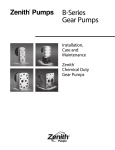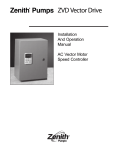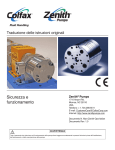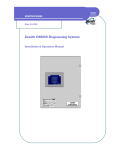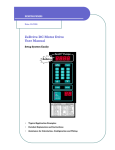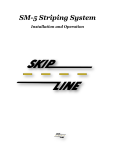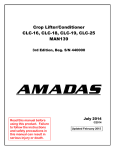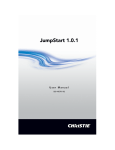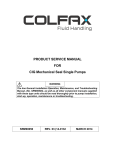Download Zenith B Specifications
Transcript
Zenith Pumps B-9000 Gear Pumps ® Installation, Care and Maintenance Zenith Chemical Duty Gear Pumps ® Thoroughly read and understand this entire manual before installation and operation of pump. ® Zenith In 1926, Zenith Pumps was approached by the synthetic fiber industry to design a pump that would provide precise, pulseless and repeatable flow while ensuring ultimate product quality. The options then were the same as those in the chemical process industry today— diaphragm, lobe, coarse gear, piston, plunger and screw pumps. Each has problems with pulsation, flow inaccuracies, multiple seal areas and slip, which require constant calibration, high maintenance and extended downtimes. Zenith Pumps met the challenge and designed a rotary external gear pump of unique precision and simplicity. Manufacturing techniques were developed to hold tolerances to ±.00005", minimizing internal clearances and assuring accurate and precise metering. The pump’s simplistic design of only three moving parts – two metering gears and a drive shaft – provided long life and reduced maintenance. For years, engineers have relied on Zenith to provide precision fluid handling solutions for their most difficult pumping applications. Zenith gear pumps can be found wherever precise, pulseless, and repeatable metering of fluids is required. Benefits High Accuracy — Stable, repeatable accuracy, ensures an exact volume per revolution without expensive flow meters. flows are assured even under varying conditions of temperature, viscosity and pressure. Precision Construction — Ground and lapped components allow for operating clearances to .00015" and provide high volumetric efficiency. Minimum Pulsation — Unique design offers virtually pulseless flow without valves or flexible elements to hinder performance. Active Flowmeter Concept — Unparalleled mechanical precision, combined with the closed loop set point Specifications three moving parts and 400 series stainless steel construction, the pump provides excellent corrosion resistance for most chemical processes, and is through-hardened to 54 Rc or better for maximum life. Experience — Zenith has over 74 years of application experience with engineers available 24 hours a day to support your precision fluid metering needs. Capacities (cc/rev): 0.05, 0.3, 0.6, 1.2, Seals: 2.4, 4.5, 9.0, 15, 30, 45, 90 Single Mechanical, Double Lip, Packed or Magnetic Recommended Speed: .05 to 30 cc/rev, up to 500 RPM 45 & 90 cc/rev, up to 300 RPM Rotation: Flow Range: Port Connections: up to 27,000 cc/Minute, (7 GPM) Metric thread or SAE 61 Standard Inlet Pressure: 300 psi (20 Bar) Max. Outlet Pressure: 1000 psi (70 Bar) Max. Differential Pressure: Optional Port Adapters: Clockwise (CW) facing drive shaft 20 to 1000 psi. (viscosity dependent) M12 X 1/4" NPT . . . . . . . . . 0.05 – 2.4 cc/rev 1/2" SAE X 1/2" NPT . . . . . . 4.5 – 9.0 cc/rev 3/4" SAE X 3/4" NPT. . . . . . . 15 – 30 cc/rev 1-1/4" SAE X 1-1/4" NPT. . . 45 – 90 cc/rev Temperature: Optional Band heaters: 0° F (-18° C) Minimum 400° F (205° C) Maximum (with magnetic coupling seal) 645° F (340° C) Maximum (dependant on shaft seal materials) 2 Low Cost of Ownership — With only 150 Watt, 115 VAC . . . . 0.05 – 2.4 cc/rev 325 Watt, 115 VAC . . . . 4.5 – 9.0 cc/rev 650 Watt, 230 VAC . . . . . 15 – 30 cc/rev 1500 Watt, 230 VAC . . . 45 – 90 cc/rev Design Zenith’s B-9000 Series precision metering pumps utilize a rotary external spur gear which dispenses an exact volume of fluid per shaft revolution (cc/rev). Precision ground and lapped construction, including alignment dowels, allows for close control of operating clearances. This ensures precise, pulseless and repeatable flow under varying process conditions. Integrated closed loop speed control and a compact motor driver system maintains up to .01% accuracy of set point speeds and also accepts automated interfaces. The B-9000 Series is constructed of 400 series stainless steel, providing excellent bearing qualities (hardness 54 Rc) and corrosion resistance for most chemical processes. The pump offers increased uptime while minimizing maintenance due to its simple design of only three moving parts. The B-9000 Series is a new generation of Zenith’s traditional B-Series pump. While maintaining precise flow characteristics, its optimum gear design reduces bearing loads, while increasing speed capability. The pump allows direct piping and shaft engagement and includes a single mechanical shaft seal, (other seal types available). Operation Fluid enters the pump through the inlet port located in the front plate and fills the gear pocket. As the gears rotate, a precise amount of fluid is trapped by the side walls of the gear pockets and gear teeth. The metered fluid is transported by the rotation of the gears to the discharge side of the pump where the gear teeth come into mesh. This action forces the fluid out of the gear teeth and through the outlet port located in the front plate. The pressure developed is determined by the pump size, the gear clearances, pump speed, fluid viscosity and impedance to flow. Pump speed is limited by practical considerations. If a high viscosity fluid is being metered and pump speed is increased beyond a certain point, the fluid may not be able to fill the gear teeth spaces, and the pump will not obtain enough fluid to maintain normal volumetric efficiency. Lack of sufficient fluid is called starvation or cavitation. This can be remedied by increasing the inlet pressure or reducing pump speed. See table 1 on page 5. Metering of thin fluids requires a different approach. Since the pump depends upon the metered fluid for lubrication of internal bearing surfaces, speeds are normally limited. These bearing surfaces include the bearing areas in the front and rear plates, and the driver gear turning about the arbor. Accelerated wear and even seizure may be the result of high speeds, especially if attended by low lubricity or a fluid containing abrasive particles. In certain applications, it is recommended to use a pump of larger capacity operated at a lower speed. Contact our Applications Engineering Department for assistance. Pump efficiency depends on four basic variables: fluid viscosity, gear clearances, differential pressure and pump speed. The less viscous the fluid, the more likely it is to flow through a given orifice. In a Zenith pump, this orifice is the gear clearance. Differential pressure forces the fluid through this clearance at a steady rate, regardless of the pump speed. Thus, the slip is constant for a given amount of time. The actual delivery of fluid is the measured delivery minus the slip. If we increase the pump speed we increase the measured delivery, while the slip remains constant, causing the pump to become more efficient. Likewise, if we slow the pump down, the pump becomes less efficient. Slip is repeatable and predictable, and pump operation can be adjusted to compensate and, thus, accuracy is very high. See Graph 1 on page 5. Zenith B-9000 Series pumps are designed for operating temperatures less than 645°F. When operating at temperatures above ambient, heat jackets should be used, and pumps should be heated slowly and uniformly to avoid warpage and internal component interference. The 400-Series stainless steels used in the construction of the B-9000 Series pumps provide sufficient corrosion resistance for most standard chemical processes. The material hardness will provide a high degree of wear resistance as well. However, processes involving corrosive or abrasive fluids should always be reviewed by Zenith. 3 Operation (continued) Magnetic Coupling Pumps In normal operation, the magnetic poles of the outer drive magnet remain aligned with the magnetic poles of the inner pump magnet. The motion of the motor is smoothly transferred to the pump shaft. If the torque load on the pump exceeds the magnetic coupling strength, then the outer magnets will rotate past the inner magnets and the magnetic poles will misalign. The outer magnet will increase to a no-load motor speed while the inner magnet remains relatively motionless. Excessive noise and vibration can be observed as the poles of a decoupled magnet move past one another. The pump should be stopped immediately if the magnets decouple. Continued operation of the motor with the magnets decoupled will reduce the future strength of the coupling. The magnets will not properly realign until the motor has been stopped. Before restarting the motor, one should determine the cause of the decoupling and remedy the problem. Decoupling does not necessarily indicate a pump failure. It indicates that an instantaneous torque requirement of the pump has exceeded the strength of the magnetic coupling supplied with the system. Without disassembly of the pump it can be difficult to determine whether the magnetic coupling or the pump internals are operating incorrectly. The following is a list of examples that could result in magnet decoupling: • Blockage or restriction in the discharge side of the system • Discharge pressure in excess of nominal conditions • Too rapid acceleration or deceleration of the drive system • An increase in fluid viscosity • Foreign particles impinging upon pump internal components • Increased friction due to a poorly lubricating process fluid 4 The decoupling characteristic of magnets can be a safety feature, preventing inadvertent pump/motor overloads. Magnets should be chosen so that their decoupling torque is greater than the pump input torque. This should include any transient, starting, and stopping conditions in addition to steady state values. The decoupling torque can vary with different fluids, temperatures, operating pressures, and magnet sizes. Accurate sizing of magnets for a specific application requires precise knowledge of several operating conditions. Check with your Zenith representative to see which 9000MD system is appropriate. General Magnetic Coupling Precautions WARNING Both the inner and outer magnetic rotors are very powerful. Handle them with care. Danger! Persons with cardiac pacemakers should stay at least 8 feet from the magnetic product at all times. Do not position hands or fingers so that they may become trapped between the two magnetic rotors, or between one magnet and a metal object. Do not position the magnets near one another unless assembling the pump to the system. Both rotors should be fastened to their respective shafts before bringing them into proximity. Do not place the magnets near any electronic equipment or media that is sensitive to magnetic fields (computers, diskettes, credit cards, etc.) When storing and assembling the magnetic coupling, make sure that no small metallic fasteners, pieces or other foreign objects adhere to the rotors or barrier cap. If the magnets de-couple, stop the drive system for the pump immediately. Determine the cause of the excessive torque requirement and remedy the problem prior to re-starting the system. Inlet Pressure Loss (psi) = Viscosity(cps) • Displacement(cc/rev) • Shaft Speed(rpm) • [(Specific Gravity • W1)+W2] Table 1 cc/rev 0.3 0.6 1.2 2.4 4.5 9.0 15.0 30.0 45.0 90.0 W1 4.29E-06 1.93E-06 1.21E-06 9.34E-07 3.00E-07 2.24E-07 1.11E-07 8.61E-08 3.38E-08 2.49E-08 W2 2.32E-06 2.47E-06 2.77E-06 3.38E-06 3.46E-07 4.19E-07 7.47E-08 9.28E-08 1.65E-08 2.02E-08 Note: This sizing procedure should be used as a guideline for estimating pump type, pump size and system requirements. Please consult Zenith to confirm pump and system selection prior to placing a purchase order. Graph 1 B-9000 or H-9000 Pump Performance 1.00 0.90 cc/r ev ev cc/r cc/rev rev 15 cc/ 1 9 & 30 4.5 & 0.1 .05 2.4 c/rev 90 c 0.01 ev 0.001 c/rev 0.00 cc/r 0.10 Key: ∆P = Pressure (psi) µ = Viscosity (cp) N = Speed (rpm) 45 c 0.20 ev 0.30 1.2 0.50 0.40 cc/r ev cc/r 0.60 0.6 0.70 0.3 Derating Factor 0.80 10 100 ∆P/(µ•N) Flowrate = pump capacity (cc/rev) x rpm x performance factor 5 Installation Pumps should always be carefully unpacked and inspected. If any items are missing or damaged, the freight carrier and Zenith should be notified immediately. While the pump is composed of stainless steel, it is a precision instrument. Dropping or hitting the pump with a non-yielding material can cause serious damage to the components. All materials are through-hardened to maximum hardness resulting in a brittle material. Treat them as you would any other precision gaging instrument. Zenith pumps are shipped filled with mineral oil. If necessary, flush the pump thoroughly with a cleaning solvent. Prior to start-up, the pump must be lubricated by either priming the pump with the process fluid, or by pouring a suitable lubricant into the inlet port. Rotate the drive shaft until lubricant appears at the discharge port. The following is a general installation procedure for Zenith B-9000 Series metering pumps. The procedure may vary slightly depending on the exact model purchased. For special applications, considerations, or technical assistance, please contact our Applications Engineering Group. It is not recommended to flush downstream process equipment utilizing Zenith precision metering pumps. Most fluids used as flushing agents, such as solvents and water, have a low viscosity and have poor lubricating qualities. Catastrophic failure may occur under certain operating conditions. If it is necessary to flush the system, the following suggestions are recommended to prevent premature pump failure: 1. If possible, flush the system using a lubricating fluid. 2. Minimize the differential pressure across the pump ports to a maximum of 25 psi. 3. Reduce the pump speed to an acceptable level (approximately 10 rpm) 4. Flush the pump for the shortest allowable time, yielding effective cleansing of the system, and no longer than necessary. 5. It is recommended to use a bypass around the pump as illustrated in Figure A. This will allow for high velocity flushing of the system while 6 minimizing risk to the metering pump. During the flush cycle, fluid will pass through and around the pump. This will allow the system to be flushed quickly and effectively. Figure A Pump Bypass Valve To prepare the pump for use: 1. Always flush the piping system before connecting it to the pump. 2. Filters should be installed upstream of the pump inlet port. The filter should ideally be sized to one half of the pumps gear clearances but, must not restrict the flow of fluid to the inlet port. 3. Turn pumps by hand before start-up to ensure free rotation. 4. For applications above ambient temperatures, if using heaters, heat the pump slowly and evenly (including the seal arrangement) prior to introducing fluid into the pump. This prevents thermal shock and material distortion. 5. Make sure that process fluid is in the pump before starting. Apply positive pressure to the pump inlet when metering high-viscosity fluids. Start Up 1. Note: The pump should never be allowed to run dry or be allowed to run with nonlubricating fluids such as water. Allow enough time for all components of the system to reach process temperature before starting the pump. Apply inlet pressure to the pump, allowing time to ensure that the process fluid has entered the pump to provide lubrication for the bearing areas. Installation (continued) 2. Before starting, remove all flow restrictions downstream of the pump to allow initial operation with as low a back pressure as possible. 3. Start the pump at the slowest speed possible and, if possible, with a lubricating fluid. Zenith B-9000 pumps must never be run without a fluid. Watch the point of discharge for evidence of fluid. If no discharge is seen after a reasonable length of time, shut down the pump and check for obstructions in the system and proper pump rotation. The term “sufficient length of time” is subjective, and cannot be quantified because of differences in installation. If, for example, a connection can be broken within a few inches of the pump outlet port, the flow would be evident with several seconds. If the distance between the pump outlet and the point of final discharge is long, more time would be needed before flow is confirmed. Cleaning, Inspection and Repair Remember: Zenith metering pumps are made for exact duty. In order to develop high pressure and minimize slip, the clearance between the metering gears and their housing must be as small as possible, yet large enough to allow adequate lubrication. All parts are machined to extreme accuracy. Critical dimensions are held between one and two tenthousandths of an inch (.0001"/.0002"). Accurate performance is dependent upon proper handling. Please handle the pumps with extreme care, and if possible, set aside a separate clean area for pump maintenance and repair. It is recommended that pump users institute a program for dimensional inspection of critical parts in order to keep maintenance and operating costs to a minimum. By noting the performance Note: The pump will discharge a cloud of bubbles when it is started, but this will subside when the air is purged from the pump. This is a normal part of pump startup. 4. When satisfactory operation is achieved, the pump and system can gradually be brought up to normal operating speed and pressure. 4. Listen for any sounds of distress when first starting the pump and turn the pump off immediately if any are heard. Investigate for causes of distress. 5. If, at any time during operation, the pump does not appear to be running smoothly, stop the pump immediately to avoid serious internal damage. of a pump immediately before removing it from service and correlating the performance to measured component wear, the maximum limit for the pump’s critical components can be established. Additionally, the service life of the pump can be predicted and downtime can be scheduled accordingly. If necessary, any Zenith precision metering pump requiring maintenance can be returned to the factory for complete repair and overhaul. For a large number of pumps, Zenith offers a contract repair service which helps to reduce repair costs and delivery time. Zenith Pumps also offers pump maintenance seminars. For more information concerning Zenith pump repair services, please contact our Customer Service Department. 7 Lapping or Blocking To remove nicks, burrs and scour marks from pump parts, place two layers of 400-Grit Emery Cloth on a lapping block or plate. A granite flat is also suitable. Apply light pressure to the part and turn it using a figure 8 motion approximately ten times until a smooth finish appears. Areas that are commonly lapped are the sides of metering gears and the inside faces of front, gear and rear plates. After lapping is completed the parts are ready to be cleaned with a safe industrial solvent. Always use clean, lint free rags and compressed air to clean components. Paper towels are not acceptable because they can leave small pieces of paper and dust on the pump parts. Use chemical brushes to clean between gear teeth, bores and reliefs. After all components are “hospital clean”, the pump can be reassembled. If cleaned parts are not to be reassembled for a period of time, they should be coated with a rust preventative fluid, such as mineral oil, to prevent rusting. New and replacement parts should always be deburred and cleaned using the above procedures. B-9000 Series Disassembly Note: As parts are disassembled, place them carefully on a clean surface such as a soft cloth. Do not allow them to knock together. Pay close attention to the order in which parts are removed. This will aid in the reassembly of the pump. Instructions below assume the pump has been removed from the system, for example, magnetically driven pumps with adapter plates have been disengaged from the housings. • On the .05 through 2.4 cc/rev models, set screws will have to be removed to allow removal of the mechanical seal (13) from the drive shaft (2). On models larger than 2.4 cc/rev, first remove the carbon seal face from the seal, then pull the mechanical seal (13) from the drive shaft (2). Some materials of the seal (face) are brittle in nature, use extreme caution so as not to damage the seal or its components. Caution: Please review the precautions listed on Page 4 for Magnetically Coupled Pumps. 1. Remove the square key (17). For Magnetically Coupled Pumps skip to step 3d. 2. For mechanical face seal and double lip seal pumps, remove the socket head screws (18) from the seal housing (11). For packing seal pumps, remove the hex head screws (15) from the packing gland (14), then lift off the packing gland. 3. Lift off the seal housing (11) and remove the seal. a) Mechanical Face Seal Pumps: • The ceramic seat may be removed from the housing by pushing it out with finger pressure. If it is stuck, use two small Allen keys or other small pins to press the seat from the housing using the two access holes on the housing face. • Remove the o-ring (15) from the recessed area in the seal housing (NOTE: .05 through 2.4 cc/rev models do not have the o-ring). 8 b) Double Lip Seal Pumps: • Press the lip seal (51) from the seal housing using finger pressure, or by pressing on the seal using a plastic tool. c) Packing Seal Pumps: • Remove the packing seal rings (13) from the Inside of the seal housing (11). • Remove the collar plate (12) from the drive shaft (2). d) Magnetically Coupled Pumps: • If applicable, remove the screws that secure the barrier cap to the adapter plate. Remove the barrier cap and its O-Ring. NOTE: There could be process fluid contained in the barrier cap. • Loosen setscrew at the bottom of the inner rotor with appropriate Allen wrench. NOTE: Beware of strong magnetic forces. Slide the inner rotor off the shaft. • Remove the square key from the pump shaft. • Remove the four socket head screws/washers that are securing B-9000 Series Disassembly (continued) the adapter plate to the pump body. Lift the adapter plate off the pump body and retrieve the ORing. 4. Loosen and remove the socket head screws (19) and (20) from the back of the rear plate (7). 5. Remove the rear plate (7). Always use the pry slots to prevent scratching precision tapped surfaces. 6. Remove the gear plate (3), being careful to note the alignment of any markings on the plate. Always use the pry slots to prevent scratching the plates. Caution: Do not allow metering gears to be lifted out with the gear plate. They may drop, causing damage to the gear teeth. Note that the slip-fit dowels (10) may come off with the gear plate. 8. Remove the driving gear (5). 9. Remove the round key (4). 10. Remove the drive shaft (2) from the front plate (8). 11. Remove the driven gear (6) from the arbor (9). 12. Remove the slip-fit dowels (10) by turning and pulling simultaneously. 13. If the arbor (9) is to be replaced or thoroughly checked, press out by using an arbor press, pressing toward the inside of the pump (the shortest press distance). 14. Replace sleeve bearings (32 & 34) in front and rear plates as necessary and hone in the plate to the original new part specifications. Contact Zenith for dimensions. NOTE: .05 through 2.4 cc/rev models do not have sleeve bearings. 7. Remove the retaining ring (16) from the shaft (2) which holds the driving gear (5) in place. Inspection and Part Preparation After the parts have been cleaned, they should be inspected for nicks, burrs and stubborn residue. The gears and the edges of the gear plate pockets are the most likely areas to be damaged because of sharp edges. An illuminated magnifier facilitates examination. 1. All flat surfaces of plates and gears should be “blocked”. Blocking is the act of rubbing the flat surface of a part on 400-grit, 500-grit or 3/0 abrasive paper, which is supported on a machinist’s or inspector’s surface plate. A few light but firm rubs usually are enough to remove residue and minor metal disturbances. Remember to use a figure 8 pattern to retain flatness and perpendicularity of holes when lapping plates. 1. Heavy disturbances or residue on front or rear plates (NOT the gear plate!) may require stronger blocking on 320-grit or even 240-grit abrasive paper followed by blocking on a finer abrasive paper. Deep score marks or metal transfer cannot be removed by blocking, and the surfaces must be ground. When surfaces are ground, care must be taken to maintain the perpendicularity of the precision ground holes with the inner plate surface. The gear plate should never be ground; to do so would reduce the axial gear clearance to the point where interference might occur when the pump is reassembled. Gears can be ground as well, but interchangeability and clearances are altered. Grinding gears is NOT recommended! 2. Gears, shafts and arbors should be lightly polished on the O.D. 3. Any nicks in the gear teeth should be removed by carefully stoning the parts with a fine India oilstone or an Arkansas stone. 4. The edges of the gear’s I.D., bearing holes and dowel holes should be lightly stoned with a round Arkansas stone to remove any nicks. Then polish the I.D. with a small piece of fine abrasive paper, 400-grit or finer. 5. After all preparation has been completed, remove the abrasive grain and loose residue in an ultrasonic cleaner or other suitable cleaning method. Abrasive grain is larger in size than the pump clearances. 6. At this point, dimensional inspection may be made if desired. 9 .05 - 2.4 cc/rev B-9000 Retaining Ring 16 Key 4 Square Key 17 Interpret per ASME-Y14.5M 1994 Driving Gear 5 19 SHCS M8x1.25 Gear Plate 3 7 Rear Plate 9 Arbor Front Plate 8 2 Drive Shaft 6 Driven Gear 10 Hollow Dowel 13 Type 8-IT Mechanical Seal 11 Seal Housing 21 Dryseal Type Plug 18 SHCS M4x0.7 Diagram 1 4.5 & 9 cc/rev B-9000 Rear Plate Assembly 7 Retaining Ring 16 Round Key 4 Interpret per ASME-Y14.5M 1994 20 SHCS M6x1 Driving Gear 5 19 SHCS M10x1.5 Gear Plate 3 33 Rear Plate Front Plate Assembly 8 34 Sleeve Bearing 9 Arbor 6 Driven Gear 10 Hollow Dowel O-Ring 15 32 Sleeve Bearing Square Key 17 31 Front Plate 2 Drive Shaft 13 Type 502 Mechanical Seal 11 Seal Housing 18 SHCS M6x1 Diagram 2 10 15 & 30 cc/rev B-9000 Rear Plate Assembly 7 Retaining Ring 16 Round Key 4 Interpret per ASME-Y14.5M 1994 Driving Gear 5 20 SHCS M6x1 Gear Plate 3 19 SHCS M12X1.75 Grade 12.9 33 Rear Plate Front Plate Assembly 8 34 Sleeve Bearing 9 Arbor 6 Driven Gear 10 Hollow Dowel O-Ring 15 32 Sleeve Bearing 31 Front Plate 2 Drive Shaft 13 Mechanical Seal 11 Seal Housing 18 SHCS M8x1.25 Diagram 3 45 & 90 cc/rev B-9000 SHCS M16x2 19 Rear Plate Assembly 7 Retaining Ring 16 Round Key 4 Interpret per ASME-Y14.5M 1994 20 SHCS M6x1 Driving Gear 5 33 Rear Plate Gear Plate 3 34 Sleeve Bearing Front Plate Assembly 8 10 Hollow Dowel Square Key 17 9 Arbor 6 Driven Gear O-Ring 15 32 Sleeve Bearing Mechanical Seal 13 31 Front Plate 2 Drive Shaft 11 Seal Housing 18 SHCS M8x1.25 Diagram 4 11 B-9000 Series Assembly Use both pages of the assembly drawing during the reassembly process to assure correct orientation of all parts. Considerable care should be taken to prevent wedging or jamming of parts. Never force the parts together. They will drop into place if properly aligned. Note: If the pump will not turn freely after each component is installed, then the last piece installed needs additional attention or replacement. Provide a can of compatible lubricant, preferably SAE-50 motor oil or mineral oil. If the pump is to be used at temperatures greater than 212°F (100°C), lubricant should be chosen for high temperature service. Shaft, arbor, dowels, and gears should be lubricated prior to assembly. Take care to remove excess fluid from between the plate surfaces using a clean towel. Threads should be lubricated with a temperature-rated, anti-seize compound. For service under 212°F (100°C), a molydisulfide-based grease may be used. During assembly, considerable care should be taken to prevent wedging or jamming of close-fitting components. Never force the parts together. They will drop into place if properly aligned. Caution: Please review the precautions listed on Page 4 for Magnetically Coupled Pumps. 1. Place the front plate (8) on a flat surface with the inner surface of the plate facing up. 2. If the arbor (9) was removed, press arbor into the front plate (8) using the driven gear (6) as a guide for pressing the arbor perpendicular (upright) into the plate. 3. Push the slip-fit dowels (10) into the dowel holes in the front plate (8). 4. Place the driven gear (6) on the arbor (9). 5. Place the gear plate (3) over the dowels (10) and driven gear (6). On .05 through 2.4cc/rev models, the gear plate may be installed in either direction. On models larger than 2.4cc/rev, align the clearance hole for the fastener (19) with the corresponding tapped hole on the front plate. 6. Install the drive shaft (2) from the opposite side of the front plate. 12 7. Install the round key (4) into the keyway on the drive shaft. 8. Slide the driving gear (5) onto the drive shaft and into the gear plate. Take care to align the keyway in the gear with the key (4). The key may need to be held down to prevent it from being damaged by the gear. 9. Install the retaining ring (16) on the rear plate end of the drive shaft (2). 10. Install the rear plate (7). 11. Install the socket head screws (19) through the rear plate (7) and torque to 50% of recommended torque (see table page 14) using a crossing pattern. Check for free rotation of the gears. If acceptable, continue to torque to full recommended torque. Again, check for free rotation of the gears. 12. Install the socket head screw (20) through the rear plate (7) and torque to recommended value. 13. Install the seal onto the drive shaft (2). NOTE: To facilitate assembly of the shaft seal, place the pump on a flat surface with the shaft in a vertical position. a) Mechanical Face Seal Pumps: • The mechanical seal (13) will be installed onto the drive shaft (2) with the carbon end facing away from the front plate (8). Take care when pressing the seal onto the shaft, as the elastomer can be damaged by the keyway or shaft edge. • On the .05 through 2.4 cc/rev models, align the set screws with the grooves machined in the drive shaft (2), then tighten the set screws. On larger models, the seal will slide up the shaft until it rests against the collar. • On 4.5 cc/rev and larger models, install the o-ring (15) into the recess in the seal housing (11). If necessary, use heavy silicone grease to keep the o-ring in place. • On 4.5 cc/rev and larger models, install the carbon seat into the mechanical seal with the exposed rib of the seat toward the ceramic seat of the seal assembly. The notches of the carbon seat should mate with the tabs of the mechanical seal. Use heavy silicone grease to keep the seat fitted to the mechanical seal. B-9000 Series Assembly (continued) • Install the ceramic seat into the seal housing (11) with the o-ring of the seat away from the mechanical seal. • Gently slide the seal housing (11) over the drive shaft (2) until the seal housing is in place and lined-up with the bolt holes on the front plate (8). • Install the socket head screws (18) into the seal housing (11) and tighten to the recommended torque. NOTE: On the .05 through 9 cc/rev models, tighten the screws using a crossing pattern. b) Double Lip Seal Pumps: NOTE: The seal assembly tool (52) is required for lip seal installation. • The inner diameter of the lip seal (51) must first be shaped before installing onto the drive shaft (2). Slide the lip seal over the seal assembly tool (52) with the springs of the lip seal being the last side inserted. The lip seal should be allowed to sit for 10-15 minutes to allow for expansion of the lips. • After the lips have expanded, the lip seal (51) should be slid off of the seal assembly tool (52), flipped over, and then reinserted onto the seal assembly tool so that the springs are the first side inserted. • Once reinserted onto the seal assembly tool (52), coat the outer rim of the lip seal (51) with a lip seal lubricant. • The lubricated lip seal (51) and the seal assembly tool (52) to which it is attached should be directed into the seal housing (11) so that the spring of the lip seal faces away from the rear of the seal housing. The seal assembly tool should be inserted completely into the seal housing and guided through the drive shaft hole until the lip seal touches and is flush with the rear wall of the seal housing. Make sure there is no gap between the lip seal and the seal housing. • Place the open end of the seal assembly tool (52) over the pump drive shaft (2). NOTE: Make sure that the key (17) is not in place on the drive shaft. Slide the lip seal (51) and seal housing (11) along the seal assembly tool until it smoothly glides over the drive shaft. Continue until the seal housing is in place and lined-up with the bolt holes on the front plate (8). • Install the socket head screws (18) into the seal housing (11) and tighten to the recommended torque. NOTE: On the .05 through 9 cc/rev models, tighten the screws using a crossing pattern. c) Packing Seal Pumps: • Slide the collar plate (12) over the drive shaft (2). • Install four new packing rings (13) into the packing housing (11). • Gently slide the packing housing (11) over the drive shaft (2). If necessary, use the flat side of the packing gland (14) to push the packing housing into place to prevent the packing rings from being pushed out of the packing housing. • Use the packing gland (14) to slightly compress the packing rings (13) and properly position the packing housing (11). • Remove the packing gland (14), taking care not to move the packing housing (11). Install the socket head screws (18) through the packing housing (11) and the collar plate (12) into the front plate (8). Tighten to the recommended torque. • Place the packing gland (14) into position over the packing housing (11). Install the hex head bolts (15) through the packing gland and tighten finger tight. d) Magnetically Coupled Pumps: • Insert the smaller O-Ring into the groove on the adapter plate, using compatible grease to retain the O-Ring into the groove. • Install the plate with the O-Ring facing the pump body using the four socket head screws and sealing washers. • Insert the square key onto the pump shaft, then slide the inner magnet onto the shaft. Refer to certified pump assembly drawing to determine the correct height/placement of the magnet. NOTE: This is critical to the pumps proper operation. • Secure the inner magnet by tightening the setscrew upon the square key. continued 13 B-9000 Series Assembly (continued) Screw Torque • Place the larger O-Ring into the exposed face of the adapter plate. Lower the barrier cap into position over the inner magnet. If applicable mount the barrier cap by installing/ tightening the eight socket head screws. Size (Metric Alloy Steel) M4 M6 M8 M10 M12 M16 14. Install the square key (17) into the drive shaft keyway. Recommended Torque (in -lbs)* 31 108 262 519 910 2250 *Lubricated values/if non-lubricated increase by 33%. Troubleshooting Possible malfunctions of the pump with their causes and remedies are listed in the following table. Trouble Probable Cause Remedy Pump will not turn 1) Drive malfunction Verify that drive powered. Assure that alarm circuits are clear. Check motor drive current and speed settings. 2) Process conditions changed Check process conditions for proper temperature, pressures, viscosities and materials. 3) Entrained particle Disassemble and clean pump; replace any damaged parts. 4) Possible internal damages Disassemble and clean pump; replace any damaged parts. Consult factory. 1) Worn seal face(s) Replace seals. Excessive seal assembly leakage 2) Improperly positioned Check seal and faces for seal or faces proper position. Reduced pump efficiency 14 3) Excessive inlet pressure Reduce inlet pressure. 1) Worn gear(s) Replace worn gear(s). 3) Process conditions changed Consult factory for gear clearance recommendations for new process conditions. FAILURE, IMPROPER SELECTION OR IMPROPER USE OF THE PRODUCTS AND/OR SYSTEMS DESCRIBED HEREIN OR RELATED ITEMS CAN CAUSE DEATH, PERSONAL INJURY AND PROPERTY DAMAGE. WARNING This document and other information from Zenith Pumps, its subsidiaries and authorized distributors provide product and/or system options for further investigation by users having technical expertise. It is important that you analyze all aspects of your application and review the information concerning the product or system in the current product catalog. Due to the variety of operating conditions and applications for these products or systems, the user, through its own analysis and testing, is solely responsible for making the final selection of the products and systems and assuring that all performance, safety and warning requirements of the application are met. The products described herein, including without limitation, product features, specifications, designs, availability and pricing, are subject to change by Zenith Pumps and its subsidiaries at any time without notice. ISO 9001: 2000 Registered Zenith® Pumps A Colfax Buisiness Unit 1710 Airport Road Monroe, NC 28110 Phone: 704-289-6511 • Fax: 704-289-9273 [email protected] • www.zenithpumps.com © Copyright 2000 Zenith Pumps B-9000 C&M 12/04















